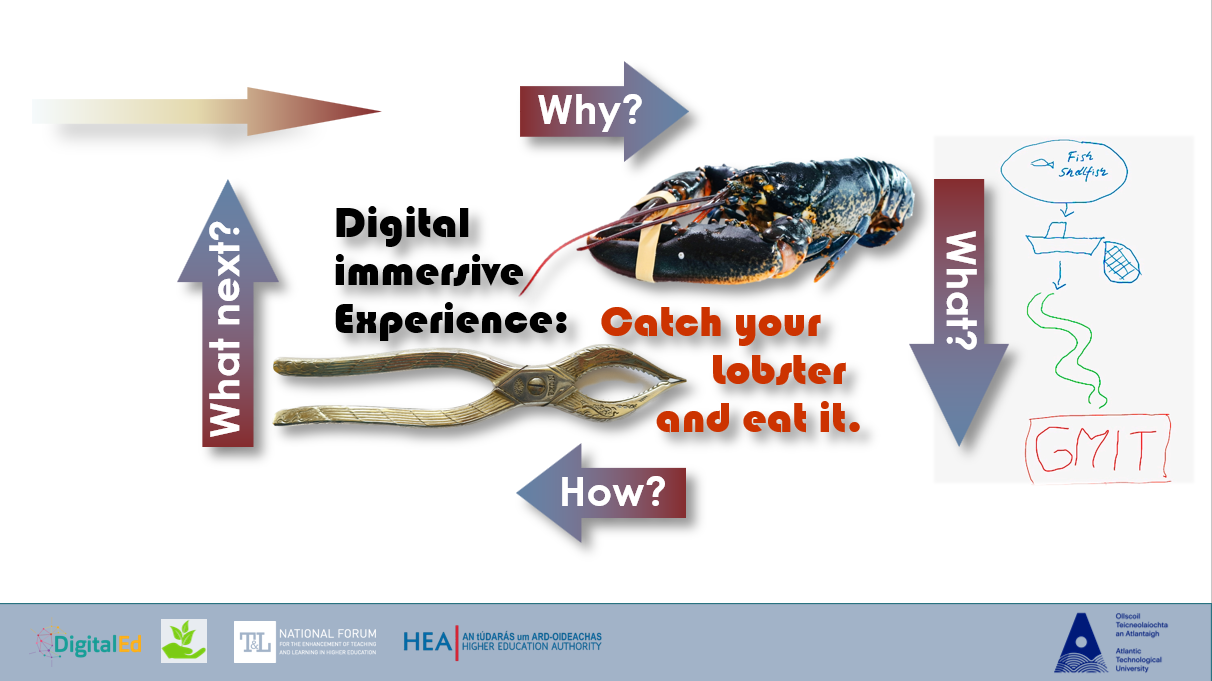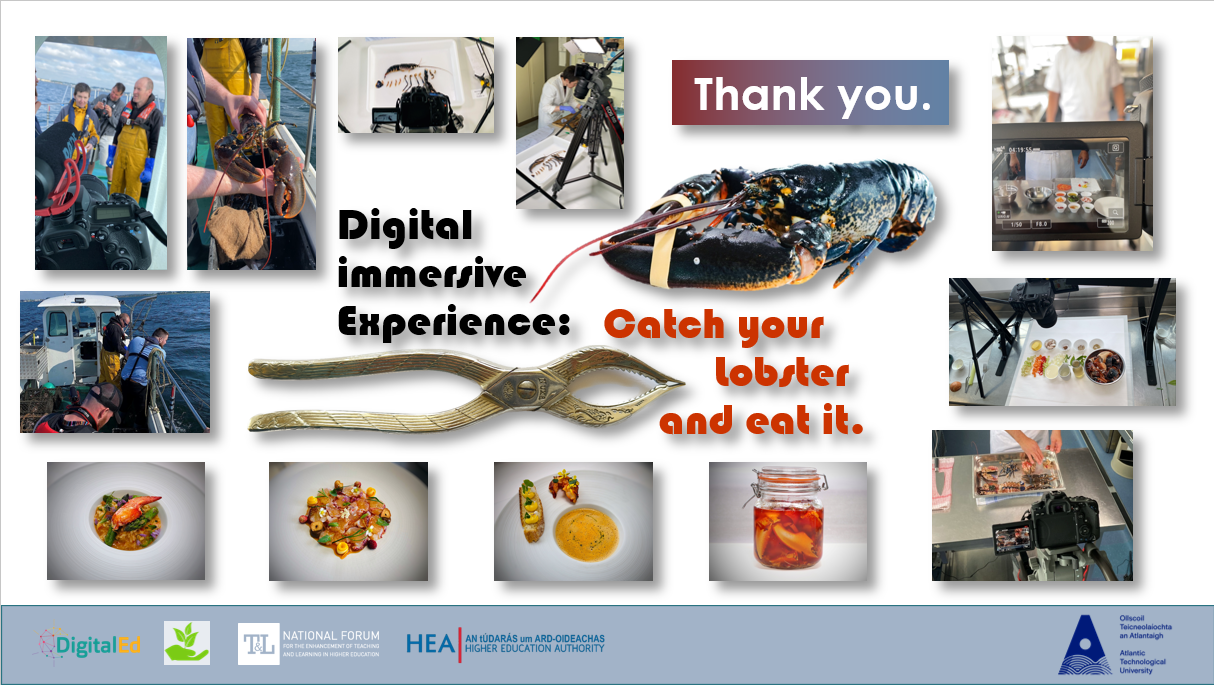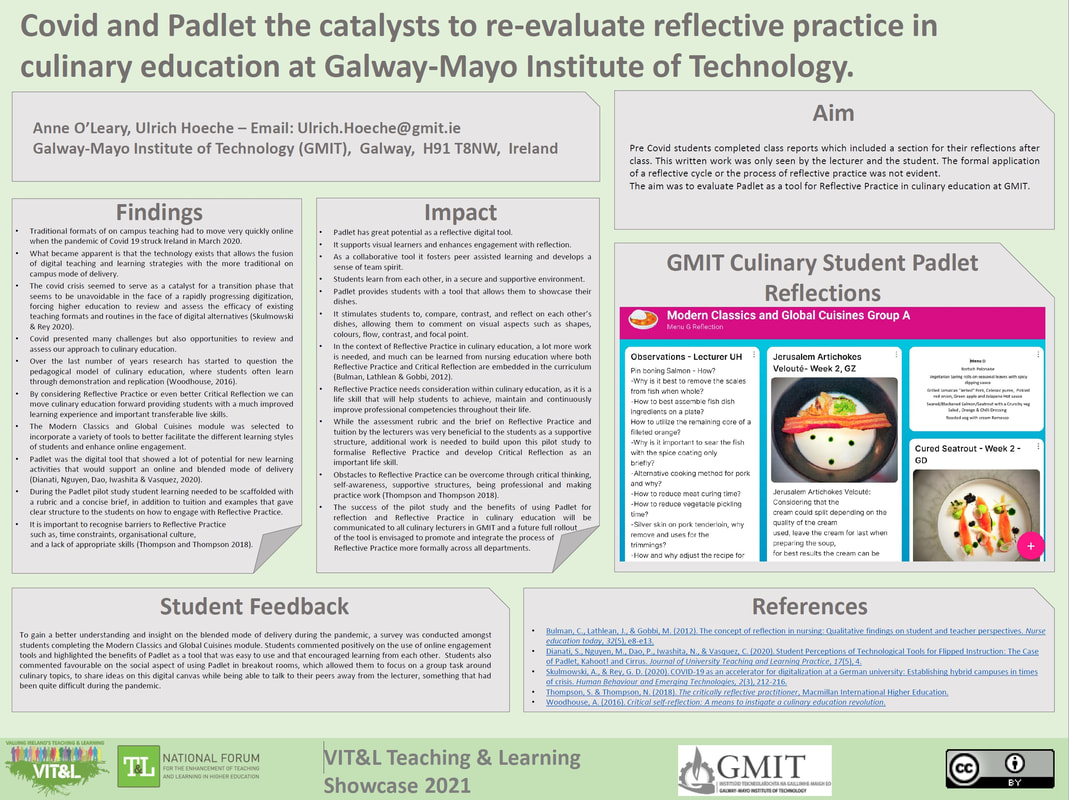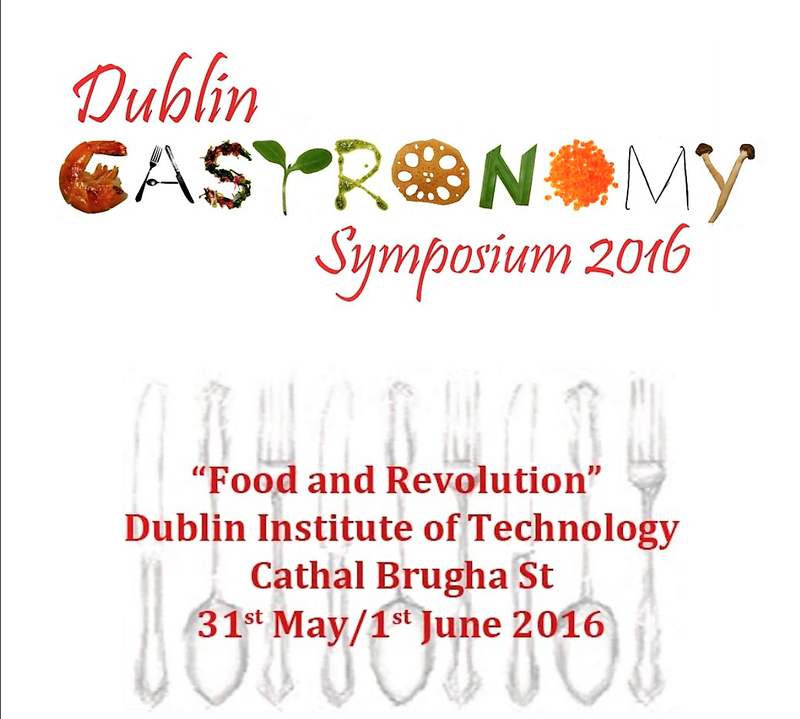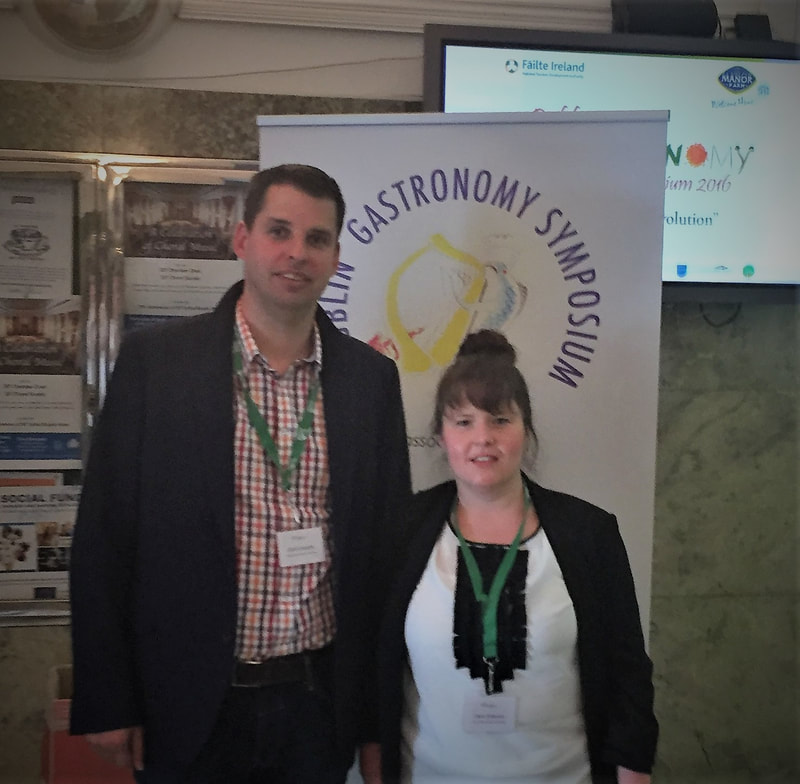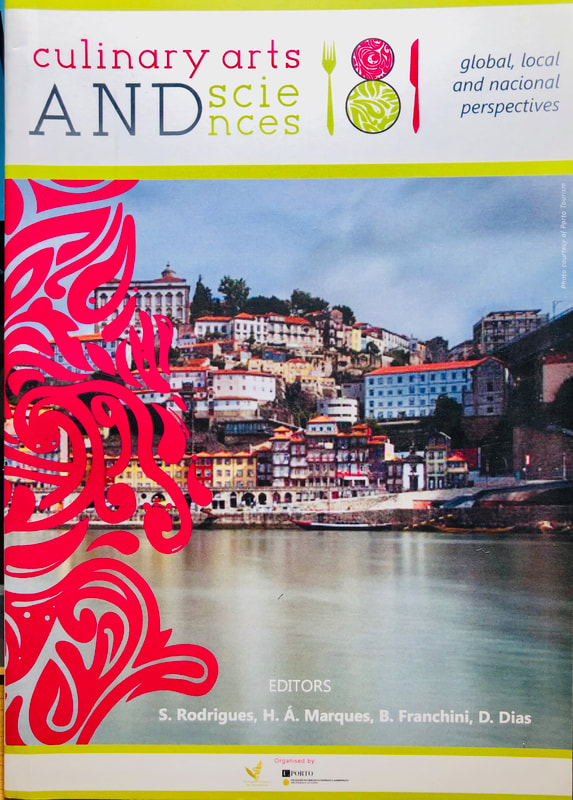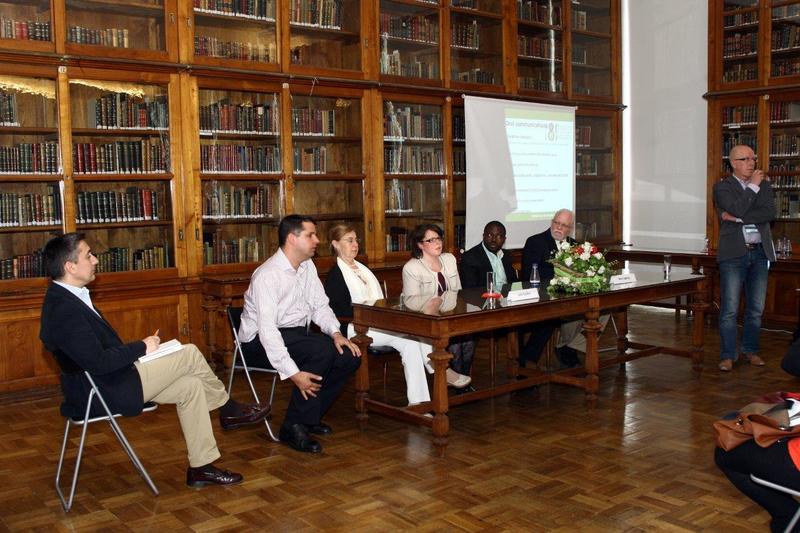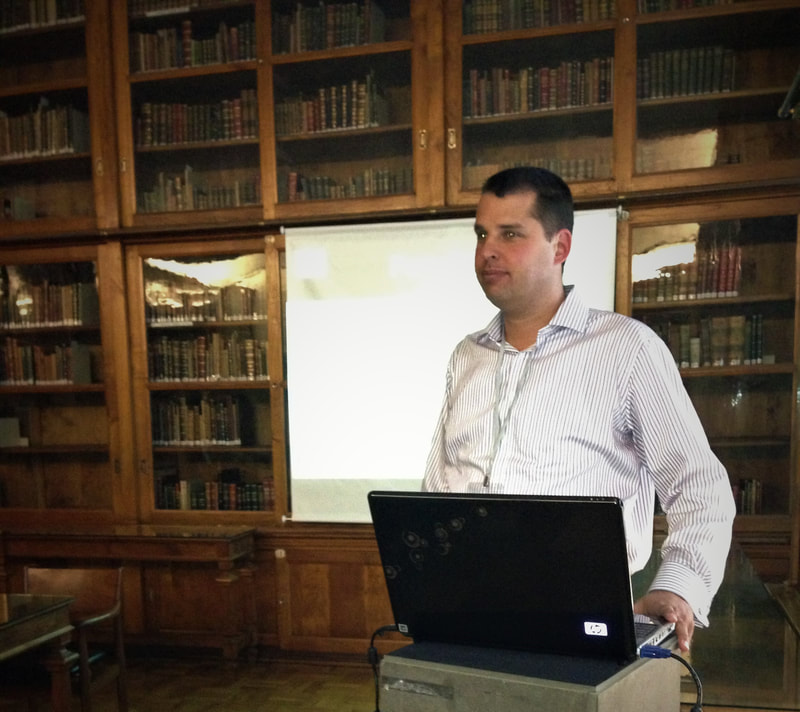1st International Conference on Ocean Education and Training (Ghent, Belgium, 9th to 11th January 2023)
Digital immersive experience: Catch your lobster and eat it.
Digital immersive experience: Catch your lobster and eat it.
|
While the Covid Pandemic seems like somewhat of a distant memory it highlighted that technology exists that allows the integration of interactive teaching and learning techniques with the more conventional on-campus style of delivery. Furthermore, the covid crisis served as a catalyst for a transition that appears to be unavoidable in the face of a rapidly progressing digitization, forcing higher education to review and assess the efficacy of existing teaching formats and routines in the face of digital alternatives. The pandemic presented a challenge but also an opportunity to evaluate fully on campus modules and redesign parts of them for a blended delivery, leveraging current technology and pedagogic tools to provide an enhanced student experience. The project Catch your lobster and I eat it was conceptualised during this time aiming to combine science and culinary arts for the development of engaging Digital Learning Resources (DLR) and immersive field, laboratory, and kitchen experiences for students. It will provide students with remote practical-based work experience opportunities. Lobster can be a somewhat difficult to access and a quite expensive commodity for students to work with in both a scientific and culinary context, and this DLR will provide virtual learning experience which will make the species more accessible to the learner. The DLR is exploring the habitat and fishing of the lobster, sustainability aspects, internal and external anatomy, quality and storage aspects, animal ethics and welfare, individual parts of the lobster and there use in a variety of recipes for a selection of dishes, from head to tail to shell, all supported by immersive detailed video documentation, tutorials and interactive quizzes all aimed at better engaging students. Apart from creating this immersive DLR, the experience gained during the development process, and lessons learned will be shared to support and inform future projects of a similar nature.
|
National Forum for the Enhancement of Teaching and Learning in Higher Education VIT&L Week Gasta Marathon (8th to 12th November 2021)
|
As part of the Gasta Marathon I presented on reflective practice in the context of culinary education with the hope to establish why it is worth our consideration for embedding it more formally in the curriculum.
Covid was the catalyst to re-evaluate the process of reflection and reflective practice in my approach to culinary education. What became very clear was that the technology exists that allows us the fusion of digital teaching and learning strategies with the more traditional on campus mode of delivery. Covid presented a challenge but also an opportunity to review and assess the way of our delivery, and in the process many digital tools were discovered that facilitate the creation structures for new learning activities that support an online and blended mode of delivery. Padlet is one of the digital tools that can help us to promote reflective practice. However it is important to scaffold student learning through a rubric and a concise brief in addition to tuition and examples in order to give a clear structure to the students on how to engage with reflective practice. Padlet has great potential as a digital tool to support blended learning and has many benefits for being reflective and beyond. It supports visual learners and enhances engagement with reflection. It is a great collaboration tool, which foresters peer assisted learning and develops a sense of team spirit. However in the context of reflective practice in culinary education, a lot of work is needed and much can be learned from nursing education were both reflective practice and critical reflection are embedded in the curriculum. Reflective practice needs our consideration as it is a life skill that will help our students to achieve, maintain and continuously improve professional competencies throughout their life's. |
|
|
Dublin Gastronomy Symposium 2016
The Sous Vide Revolution! Coming full circle and beyond. Sous vide is a method of cookery used since the late 1960s, whereby food is placed in a vacuum-sealed plastic pouch and poached for a specific time at a precise temperature. The Sous Vide process was developed originally for both the restaurant sector and the food manufacturing industry to pasteurise industrial foods in order to achieve a longer shelf life. This technique, however has seen a revolution in the last number of years. The cooking method was extensively used in food manufacturing since it’s conception, but by now, sous-vide cooking has not only come full circle by finding its way back into restaurant kitchens, but the method is now being made available to the domestic household with a variety of appliances. Moreover, in the catering sector, especially high-end gastronomy, sous vide has gained unprecedented momentum due to the favourable contribution to the aroma, texture and nutritional profile of foods.
The aim of this study is to give an insight into the history and evolution of sous vide, as well as examining the interconnection between catering and food manufacturing, which pushed the development and has given rise to what is known as sous vide today. The study will further investigate how advances in food science and a renewed interest in understanding cookery at a deeper level, both by chefs and the food manufacturing industry, has led sous vide to become an integral part of modern food production and revolutionised the way food is being cooked today.
|
| ||||||
|
ICCAS 2013 (8th International Conference on Culinary Arts and Sciences in Porto, Portugal)
Foraging – why back to nature, why now and for how long? An exploratory study into to the renaissance of foraging. Foraging has undergone an unprecedented renaissance around the globe since the last decade. The research conducted has highlighted several issues surrounding foraged foods- Eating locally and seasonally, as well as the recession certainly made the concept of food for free attractive. In addition to this, health and wellbeing are two of the main key drivers contributing to its growing popularity. Advocates of foraged foods claim that it is healthier and safer than most mass produced foods. Nonetheless, foraged foods demand premium prices in the market place. Their exclusivity is self-perpetuating at times; exclusive means expensive, and expensive keeps it on the periphery. That said, increasingly in the past 10 years, consumers, more educated than ever on the science of food, preservatives and agri-business, have been shifting towards a basic approach to food—an approach that finds foraged foods appealing.
As the demand for foraged foods grows, sustainability will become a significant concern should the increase in foraging activities continue.
|
| ||||||

